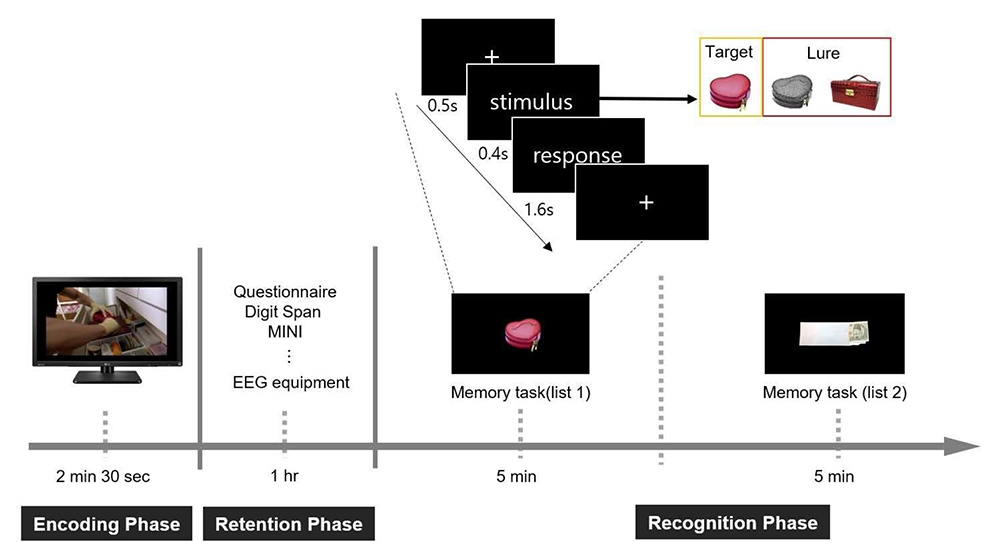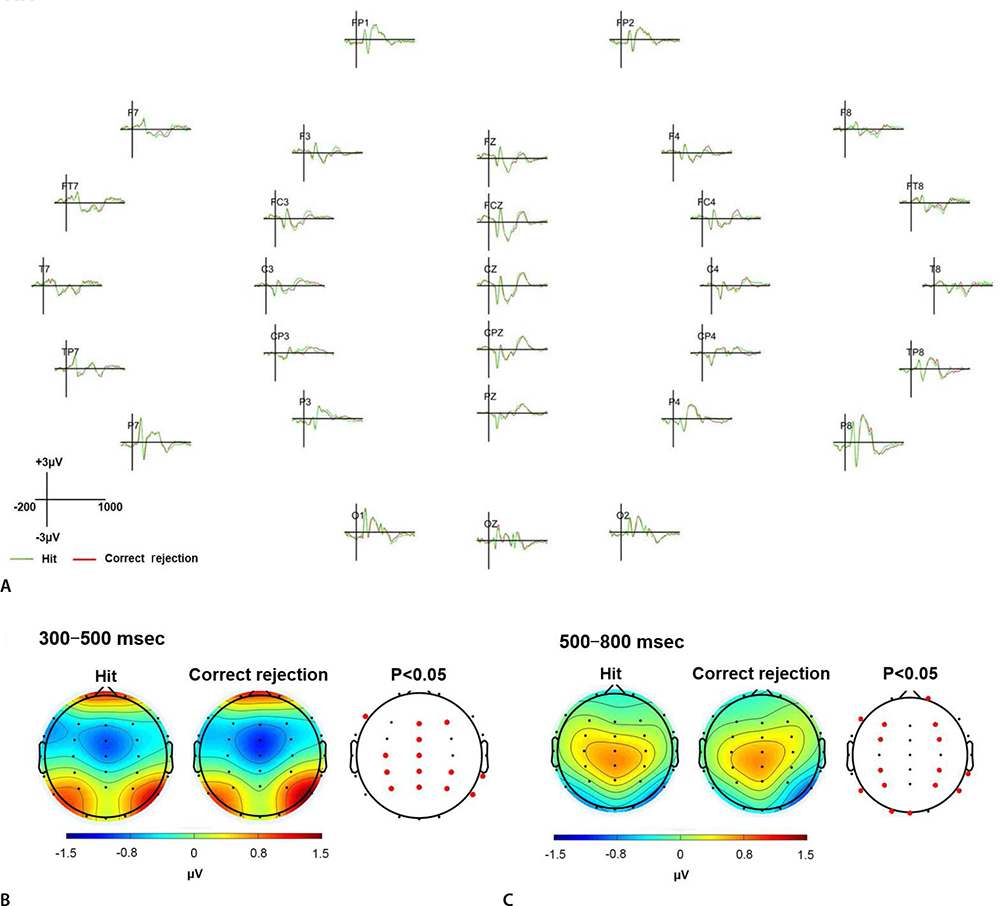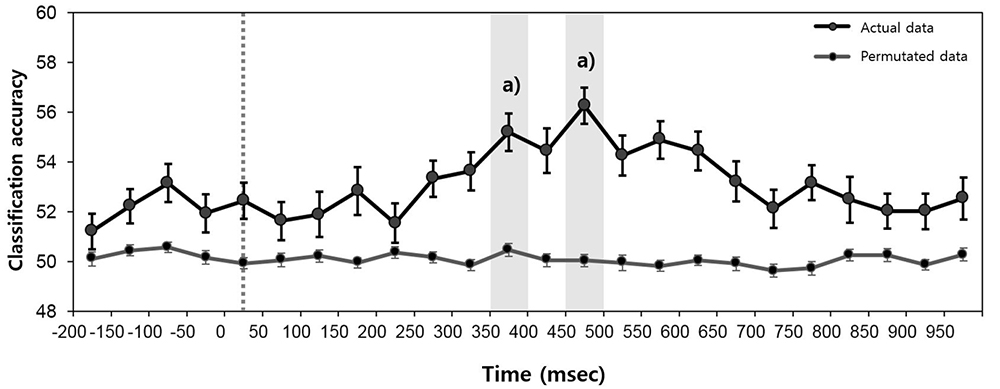Korean J Leg Med.
2018 May;42(2):62-70. 10.7580/kjlm.2018.42.2.62.
The Assessment of Eyewitness Memory Using Electroencephalogram: Application of Machine Learning Algorithm
- Affiliations
-
- 1Psychological Forensics Division, National Forensic Service, Wonju, Korea. ksham@korea.kr
- 2Department of Forensic Medicine, Institute of Forensic Medicine, Seoul National University College of Medicine, Seoul, Korea. yoosh@snu.ac.kr
- KMID: 2412862
- DOI: http://doi.org/10.7580/kjlm.2018.42.2.62
Abstract
- This study was conducted to investigate whether memory accuracy can be assessed by analyzing electrophysiological responses (i.e., electroencephalography [EEG]) for retrieval cues related to the witnessed scene. Specifically, we examined the different patterns of EEG signals recorded during witnessed (target) and unwitnessed (lure) stimuli using event-related potential (ERP) analysis. Moreover, using multivariate pattern analysis, we also assessed how accurately single-trial EEG signals can classify target and lure stimuli. Participants watched a staged-crime video (theft crime), and the EEG signals evoked by the objects shown in the video were analyzed (n=56). Compared to the target stimulus, the lure stimulus elicited larger negative ERPs in frontal brain regions 300 to 500 milliseconds after the retrieval cue was presented. Furthermore, the EEG signals observed 450 to 500 milliseconds after the retrieval cue was presented showed the best classification performance related to eyewitness memory, with the mean classification accuracy being 56%. These results suggest that the knowledge and techniques of cognitive neuroscience can be used to estimate eyewitness memory accuracy.
Keyword
MeSH Terms
Figure
Cited by 1 articles
-
Increased Ventrolateral Prefrontal Cortex Activation during Accurate Eyewitness Memory Retrieval: An Exploratory Functional Near-Infrared Spectroscopy Study
Keunsoo Ham, Ki Pyoung Kim, Hojin Jeong, Seong Ho Yoo
Korean J Leg Med. 2018;42(4):146-152. doi: 10.7580/kjlm.2018.42.4.146.
Reference
-
1. Wells GL, Memon A, Penrod SD. Eyewitness evidence: improving its probative value. Psychol Sci Public Interest. 2006; 7:45–75.2. Schacter DL, Loftus EF. Memory and law: what can cognitive neuroscience contribute. Nat Neurosci. 2013; 16:119–123.
Article3. Lefebvre CD, Marchand Y, Smith SM, et al. Determining eyewitness identification accuracy using event-related brain potentials (ERPs). Psychophysiology. 2007; 44:894–904.
Article4. Lefebvre CD, Marchand Y, Smith SM, et al. Use of event-related brain potentials (ERPs) to assess eyewitness accuracy and deception. Int J Psychophysiol. 2009; 73:218–225.
Article5. Rugg MD, Mark RE, Walla P, et al. Dissociation of the neural correlates of implicit and explicit memory. Nature. 1998; 392:595–598.
Article6. Yonelinas AP. Receiver-operating characteristics in recognition memory: evidence for a dual-process model. J Exp Psychol Learn Mem Cogn. 1994; 20:1341–1354.
Article7. Yonelinas AP. The nature of recollection and familiarity: a review of 30 years of research. J Mem Lang. 2002; 46:441–517.
Article8. Rugg MD, Curran T. Event-related potentials and recognition memory. Trends Cogn Sci. 2007; 11:251–257.
Article9. Curran T. Effects of attention and confidence on the hypothesized ERP correlates of recollection and familiarity. Neuropsychologia. 2004; 42:1088–1106.
Article10. Curran T, Cleary AM. Using ERPs to dissociate recollection from familiarity in picture recognition. Brain Res Cogn Brain Res. 2003; 15:191–205.
Article11. Curran T, Hancock J. The FN400 indexes familiarity-based recognition of faces. Neuroimage. 2007; 36:464–471.
Article12. Curran T. Brain potentials of recollection and familiarity. Mem Cognit. 2000; 28:923–938.
Article13. Ham K, Pyo C, Jang T, et al. Estimation of eyewitness identification accuracy by event-related potentials. Korean J Leg Med. 2015; 39:115–119.
Article14. Chang CC, Lin CJ. LIBSVM: a library for support vector machines. ACM Trans Intell Syst Technol. 2011; 2:1–27.15. Bode S, Feuerriegel D, Bennett D, et al. The Decision Decoding ToolBOX (DDTBOX): a novel multivariate pattern analysis toolbox for event-related potentials. bioRxiv. 2017; [Epub]. DOI: 10.1101/153189.
Article16. Haxby JV, Gobbini MI, Furey ML, et al. Distributed and overlapping representations of faces and objects in ventral temporal cortex. Science. 2001; 293:2425–2430.
Article17. Noh E, Herzmann G, Curran T, et al. Using single-trial EEG to predict and analyze subsequent memory. Neuroimage. 2014; 84:712–723.
Article18. Nemrodov D, Niemeier M, Mok JN, et al. The time course of individual face recognition: a pattern analysis of ERP signals. Neuroimage. 2016; 132:469–476.
Article19. Yoo SW, Kim YS, Noh JS, et al. Validity of Korean version of the mini-international neuropsychiatric interview. Anxiety Mood. 2006; 2:50–55.20. On-Site Tracking Siren. No. 372 [TV]. Busan: Korea New Network Corporation;2011.21. Delorme A, Makeig S. EEGLAB: an open source toolbox for analysis of single-trial EEG dynamics including independent component analysis. J Neurosci Methods. 2004; 134:9–21.
Article22. Benjamini Y, Hochberg Y. Controlling the false discovery rate: a practical and powerful approach to multiple testing. J Royal Stat Soc Series B Methodol. 1995; 57:289–300.
Article23. Hallett M. Movement-related cortical potentials. Electromyogr Clin Neurophysiol. 1994; 34:5–13.24. Kok A. Overlap between P300 and movement-related-potentials: a response to Verleger. Biol Psychol. 1988; 27:51–58.
Article25. Sun X, Qian C, Chen Z, et al. Remembered or forgotten?: an EEG-based computational prediction approach. PLoS One. 2016; 11:e0167497.26. Pastotter B, Bauml KT. Distinct slow and fast cortical theta dynamics in episodic memory retrieval. Neuroimage. 2014; 94:155–161.
Article
- Full Text Links
- Actions
-
Cited
- CITED
-
- Close
- Share
- Similar articles
-
- Estimation of Eyewitness Identification Accuracy by Event-Related Potentials
- Increased Ventrolateral Prefrontal Cortex Activation during Accurate Eyewitness Memory Retrieval: An Exploratory Functional Near-Infrared Spectroscopy Study
- Application of Machine Learning in Rhinology: A State of the Art Review
- Classification of Adolescent Psychiatric Patients at High Risk of Suicide Using the Personality Assessment Inventory by Machine Learning
- Classification of BMI Control Commands Using Extreme Learning Machine from Spike Trains of Simultaneously Recorded 34 CA1 Single Neural Signals




